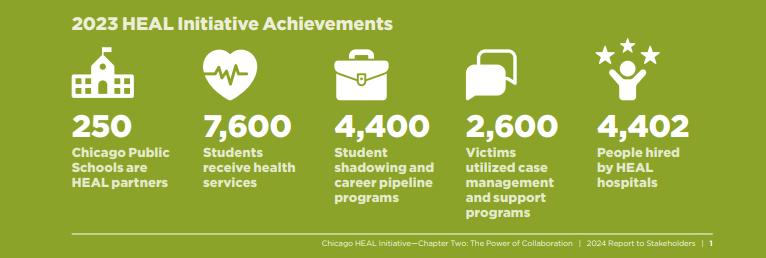Section 7|External Engagement and Reporting
7.1 Aligning Anchor Mission with Other Local, State, and National Initiatives
While integrating anchor mission practices internally takes intention, time, and addressing implementation challenges, institutions must also create a space to contribute to larger external initiatives that drive economic growth. Many external initiatives do this by aligning institutions around a common goal and establishing data collection and reporting practices that facilitate greater collaboration and collective impact to achieve it. Although these additional reporting cadences to anchor mission strategies may seem counterintuitive, Rush has found that this additional data collection helps strengthen and grow its anchor mission approach over time. Aligning with external partners and initiatives is helpful to secure and advance anchor mission initiatives as part of the larger ecosystem of economic and community development. For Rush, Illinois U.S. Senator Richard Durbin’s HEAL Initiative and West Side United have been instrumental in bringing publicity, resources, funding, and strategic direction to the anchor mission and thereby helping to scale its success.
7.2 Senator Durbin’s HEAL Initiative
In Chicago, the HEAL (Hospital Engagement, Action, and Leadership) initiative, led by U.S. Senator Richard Durbin, has brought together a collective of 10 hospitals across Illinois focused on decreasing violence in their respective communities through an approach that involves data sharing and collaboration among hospital members.The initiative has created a network of healthcare providers and community organizations working to reduce violence and improve the overall health of residents in 18 underserved neighborhoods on Chicago’s South and West Sides. This initiative has enabled Rush to align both its local hiring and local purchasing strategies as part of a larger mission to achieve violence reduction in Chicago. Since its inception, all 10 hospitals meet regularly as collaborators, rather than competitors, to advance health equity and anchor mission strategies. Rush reports on its workforce development efforts (along with data on its community-based practices) on an annual basis. The initiative has made significant progress in addressing the root causes of violence and health disparities.
7.3 West Side United (WSU)
West Side United (WSU) is a group of Chicago health care institutions, residents, civic leaders, and health care professionals that include Rush University Medical Center, that are committed to reducing the 14-year gap in life expectancy between people living in Chicago’s Loop and in some of the city’s West Side neighborhoods. Rush’s incubation of WSU and the impact of WSU acting as a catalyst for anchor mission initiatives on Chicago’s West Side has been widely documented.
In the time since the publication of the original Anchor Mission Playbook, Rush has collaborated with WSU to scale and standardize its impact investments, leverage the collective power of other West Side hospitals for collaborative local purchasing initiatives, and collectively engage West Side vendors for purchasing opportunities. Partnering with WSU has provided the opportunity for Rush to advance anchor mission strategies across other institutions that want to adopt anchor mission practices, all while developing strategies to standardize and further develop its own contributions to the field. Rush reports to WSU on its anchor mission initiatives on a quarterly basis, and the WSU team creates a report containing data that details the collective impact of the WSU anchor collective.

7.4 Healthcare Anchor Network
As a founding member of the Healthcare Anchor Network, Rush submits an annual report on several metrics across its anchor mission initiatives as part of HAN’s framework for data collection and evaluation. Since 2018, HAN has worked in collaboration with its members to standardize nearly 50 indicators for the areas of Human Resources, Supply Chain, Treasury, and Sustainability. One of the critical shifts—or a systemic change in the healthcare sector that needs to occur to normalize the anchor mission approach is the need to build a compelling evidence base for this work. The HAN framework for evaluation and metrics collection seeks to create an understanding of the connections between program level activities within health systems (e.g., impact purchasing) and health and economic outcomes in their communities (e.g., health disparity measures). Collecting this data will help enable systems to track their progress in creating more equitable and healthy communities through the adoption of anchor strategies. For Rush, HAN’s evaluation and metrics collection framework has helped establish benchmarks for success that are necessary to assess progress by leveraging data provided by a variety of anchor mission practitioners nationwide.
